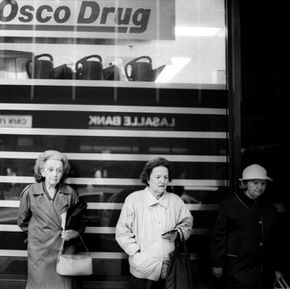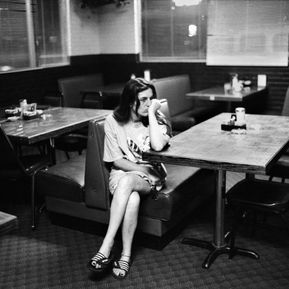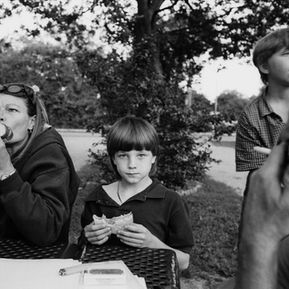FOTOTECA SIRACUSANA
PHOTOGALLERY - FOTOGRAFIA VINTAGE - BIBLIOTECA TEMATICA - CAMERA OSCURA B&W - DIDATTICA
SCRIPTPHOTOGRAPHY
Edward KEATING (Usa)

EDWARD KEATING
Recita il verso di una celebre canzone americana: “Well, if you ever plan to motor west Jack, take my way, it's the highway, that's the best. Get your kicks on Route 66”. È stata cantata, filmata, percorsa, sognata. È più di una autostrada, è un mito d’asfalto che collega Chicago a Los Angeles adunando le ambizioni del “sogno americano. È la Route 66, che in “Furore” John Steinbeck definì “the Mother Road”, la “Madre di tutte le strade”. Edward Keating ha lungamente viaggiato lungo la Route 66 seguendo il percorso di agricoltori migranti, di hobos, di donne e uomini con radici da pacificare, avventurandosi da ovest verso est e poi indietro per documentare la vita degli americani che lungo quella strada vi si sono stabiliti, ovunque le loro ossa e le loro macchine rotte li abbiano lasciati cadere. Lungo le 2.400 miglia non c’è peccato né virtù. Ci sono solo cose che fanno le persone. La misericordia si apre a ogni passaggio, la speranza a ogni svincolo. Ogni città lungo il tragitto somiglia a un’immagine salvifica cui aggrapparsi. Non c’è automobilista, autostoppista che sulla Route 66 non si sia sentito un naufrago appena sottratto ai gorghi risucchianti d’un mare in tempesta. Keating ripercorre più o meno letteralmente le suggestioni toponomastiche della celebre canzone: Chicago, St. Louis, Amarillo, Gallup, Winona, Barstow, San Bernardino si aprono in un racconto che di diverso ha solo i protagonisti. Il sogno americano si consuma nella consuetudine d’una vita stemperata nella disillusione, in quel “keep on keepin’ on”, quel continuare ad andare avanti a dispetto di ogni avversità, fermo tra il grandioso della quotidianità e le anime in transito nell’affollato via vai di una stazione degli autobus, su cui ha preso posto Joe Buck in un viaggio a ritroso. “The Mother Road” di Edward Keating è la storia d’una ispirazione fattasi strada, d’una lotta contro un destino, lo stesso che se da un lato blandisce dall’altro condanna, e gli esclusi, come sempre, ovunque essi vivano, sono in numero assai maggiore. Gli americani di Keating sono parenti di quelli di Frank. Le facce sono più dure, forse deluse; forse hanno visto il futuro passargli davanti e non hanno saputo fermarlo, forse sono vittime sacrificali. Di certo lo è la prostituta texana, sprofondata nella plumbea solitudine, là dove prendono vita i fantasmi delle disillusioni. Non meno estraniante è l’atmosfera resiliente d’una sala da ballo di musica country, dove a trovare una mediazione con la solitudine sono solo i due trasognati ballerini. L’America che irrora la Route 66 getta ai suoi lati illusioni e veleno secondo una logica imperscrutabile e crudele, come un puzzle gettato in aria e ai cui pezzi è vietata la ricomposizione. Il reportage di Keating è asciutto, non cede alle lusinghe né alla commiserazione: è un paesaggio da vedere in un fiato, da dietro il finestrino di un autobus o di un’automobile in corsa e dove, nel pulviscolo delle incoerenze, si cela la determinata fiducia in un tempo diverso, migliore. La Route 66 è dunque una grandiosa metafora di uomini e cose, è un piano inclinato su cui scivola l’intera storia dell’uomo. Fermarla non è possibile, conoscerla è necessario.
Giuseppe Cicozzetti
da “The Mother Road”
foto Edward Keating
The verse of a famous American song reads: “Well, if you ever plan to motor west, Jack, take my way, it's the highway, that's the best. Get your kicks on Route 66 ". It was sung, filmed, traveled, dreamed.
It's more than a highway, it's an asphalt myth that links Chicago to Los Angeles, meeting the ambitions of the "American dream." It is Route 66, which in "Grapes of Wrath" John Steinbeck called "the Mother Road".
Edward Keating has long traveled along Route 66 following the path of migrant farmers, hobos, women and men with roots to pacify, venturing from west to east and then back to document the lives of Americans who settled there along that road, wherever their bones and their broken machines let them fall. Along the 2,400 miles there ain’t no sin or virtue.
There are only things people do. Mercy opens up at every step, hope at every junction. Each city along the way looks like a saving image to cling to. There is no motorist, hitchhiker who on the Route 66 did not hear a shipwrecked man who had just been stolen from the whirlpools of a stormy sea. Keating traces more or less literally the toponymic suggestions of the famous song: Chicago, St. Louis, Amarillo, Gallup, Winona, Barstow, San Bernardino open up in a story that only the protagonists have differently.
The American dream is consumed in the habit of a life dissolved in disillusionment, in that "keep on keepin’ on", despite all adversity, caught between the grandeur of everyday life and the souls in transit in the crowded coming and going of a bus station, on which Joe Buck took place on a journey backwards. "The Mother Road" by Edward Keating is the story of an inspiration made on the road, of a struggle against a destiny, the same that if on one side blandish on the other condemnation, and the excluded ones, as always, wherever they live, they are in far greater numbers.
Keating Americans are relatives of Frank's. The faces are harder, perhaps disappointed; perhaps they have seen the future pass in front of them and they have not been able to stop it, perhaps they are sacrificial victims. Certainly it is the Texan prostitute, sunk in the leaden solitude, where the ghosts of disillusionment come to life. No less alienating is the resilient atmosphere of a country music ballroom, where only the two dreamy dancers find a mediation with solitude.
The America that sprays Route 66 throws illusions and poison to its sides according to an inscrutable and cruel logic, like a puzzle thrown in the air and whose pieces cannot be reassembled. Keating's report is dry, does not yield to flattery or commiseration: it is a landscape to be seen in one breath, from behind the window of a bus or a racing car and where, in the dust of inconsistencies, lies the determined trust in a different time, better. Route 66 is therefore a great metaphor for men and things, it is an inclined plane on which the entire history of man slips. Stopping it’s not possible, knowing it’s necessary.
Giuseppe Cicozzetti
from “The Mother Road”
ph. Edward Keating











